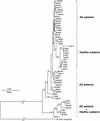Sequence diversity of the intergenic spacer region of the rRNA gene of Malassezia globosa colonizing the skin of patients with atopic dermatitis and healthy individuals
- PMID: 12843037
- PMCID: PMC165282
- DOI: 10.1128/JCM.41.7.3022-3027.2003
Sequence diversity of the intergenic spacer region of the rRNA gene of Malassezia globosa colonizing the skin of patients with atopic dermatitis and healthy individuals
Abstract
The lipophilic yeast Malassezia globosa is one of the major constituents of the mycoflora of the skin of patients with atopic dermatitis (AD). We compared the genotypes of M. globosa colonizing the skin surface of 32 AD patients and 20 healthy individuals for polymorphism of the intergenic spacer (IGS) 1 region of the rRNA gene. Sequence analysis demonstrated that M. globosa was divided into four major groups, which corresponded to the sources of the samples, on the phylogenetic tree. Of the four groups, two were from AD patients and one was from healthy subjects. The remaining group included samples from both AD patients and healthy subjects. In addition, the IGS 1 region of M. globosa contained short sequence repeats: (CT)(n), and (GT)(n). The number of sequence repeats also differed between the IGS 1 of M. globosa from AD patients and that from healthy subjects. These findings suggest that a specific genotype of M. globosa may play a significant role in AD, although M. globosa commonly colonizes both AD patients and healthy subjects.
Figures




References
-
- Aspiroz, C., L. A. Moreno, A. Rezusta, and C. Rubio. 1999. Differentiation of three biotypes of Malassezia species on human normal skin. Correspondence with M. globosa, M. sympodialis and M. restricta. Mycopathologia 145:69-74. - PubMed
-
- Diaz, M. R., T. Boekhout, B. Theelen, and J. W. Fell. 2000. Molecular sequence analyses of the intergenic spacer (IGS) associated with rDNA of the two varieties of the pathogenic yeast, Cryptococcus neoformans. Syst. Appl. Microbiol. 23:535-545. - PubMed
Publication types
MeSH terms
Substances
Associated data
- Actions
- Actions
- Actions
- Actions
LinkOut - more resources
Full Text Sources
Other Literature Sources
Miscellaneous

